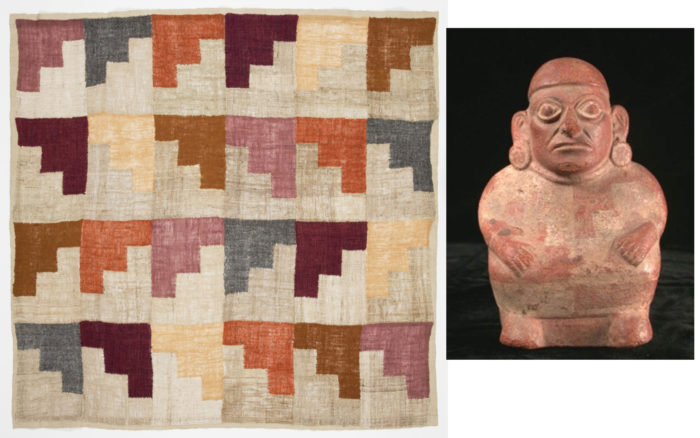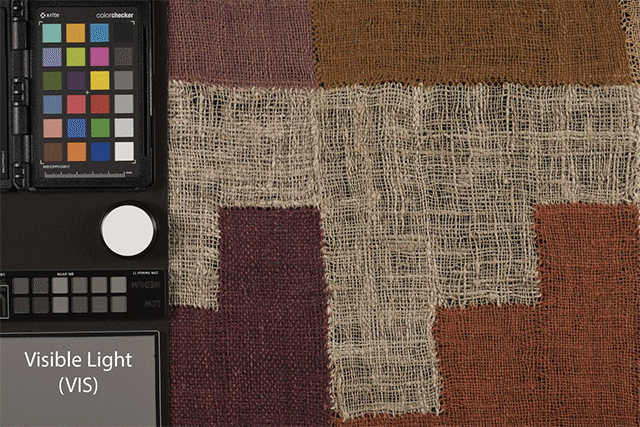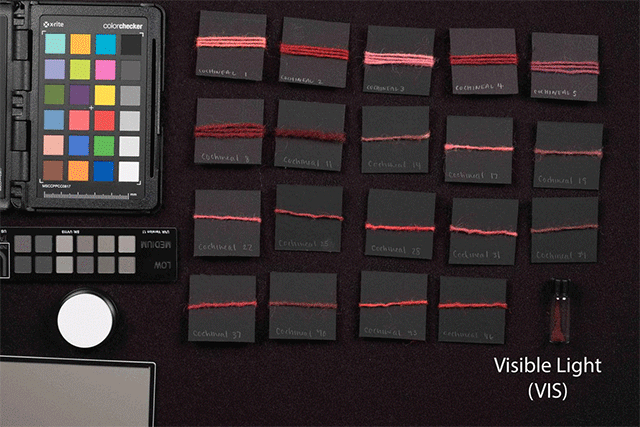
(left) Textile, Six X Four II, 2009; James Bassler (American, b. 1933); H x W: 116.8 × 123.2 cm (46 × 48 1/2 in.); hemp, cochineal-dyed alpaca, natural brown cotton, natural alpaca; Museum purchase through gift of Elena Phipps; 2018-19-1; (right) Stirrup Spout Bottle featuring a step-motif tunic (Peru, North Coast); Moche, Early Intermediate Period (A.D. 100-600); Bichrome Pottery; H x W x D: 16 x 12 x 15 cm; University of Florida, P2291; https://www.floridamuseum.ufl.edu/latinarch/catalog/andean-artifacts
by Jessica Walthew (objects conservator), Kira Eng-Wilmot (textile conservator), and Pauline Nguyen (conservation intern)
Several contemporary designers featured in our current exhibition Nature by Design: Cochineal (November 16, 2019–May 25, 2020) were inspired by historic materials and chose this fascinating cochineal dyestuff for their work. James Bassler’s textile Six X Four II is made with discontinuous warps and wefts, a technique unique to Andean weaving that Bassler studied and recreated in his contemporary homage to ancient textiles. The textile also uses motifs, fibers, and dyes common to historic textiles from the Andes region. Native cotton grown in Peru comes in a variety of colors other than the white we are most familiar with today, and was used along with hemp fiber and dyed alpaca wool to create the pleasing palette of the geometric gridded step-motifs, much like the tunic depicted on the Moche sculpted pot shown in the image above.

Animated GIF showing detail area of James Bassler’s textile Six X Four II imaged in different conditions: visible light, ultraviolet luminescence, and visible-induced luminescence.
In our previous post, we described how MBI is useful for understanding textiles dyed with cochineal. The results we obtained from imaging reference samples made with known fiber and mordant combinations allows us to compare them with images we captured of the Bassler textile. The pink, dark red, and orange dyes luminesce (appear bright) under ultraviolet light. In the visible induced luminescence (VIL) image however, these dyes appear different. The pink and dark red dyes have a faint glow consistent with reference samples where cochineal dyes modified with an acid were used. The orange dye appears dark in this image, and is unlikely to be cochineal.

Animated gif showing wool samples dyed with cochineal under different imaging conditions: visible light (VIS), ultraviolet luminescence (UVL), and visible-induced luminescence (VIL) (note: VIL has enhanced exposure)
As this case study shows, MBI is a quick, non-invasive, yet informative technique that provides us with important clues about the materials used in textiles in the collection. In order to confirm these results, we may pursue more sophisticated chemical analysis in partnership with a conservation science lab.
Acknowledgements: Cooper Hewitt’s imaging suite was purchased with funds granted from the Smithsonian Research Equipment Pool. Our special thanks to Dawn Kriss and Anna Serotta for training and advice, and Pauline Nguyen for her work carrying out the imaging during her 2019 Krueger summer internship in conservation.
References
Phipps, Elena. (2010) Cochineal Red: The Art History of a Color [adapted from The Metropolitan Museum of Art Bulletin, v. 67, no. 3 (Winter, 2010)] (Download free pdf: https://www.metmuseum.org/art/metpublications/Cochineal_Red_the_art_history_of_a_color
Phipps, Elena (2018). James Bassler, Thread by Thread. Cooper Hewitt Object of the Day, Sept. 20, 2018/November 18, 2019 reposted. https://www.cooperhewitt.org/2018/09/20/james-bassler-thread-by-thread/
Vitorino, Tatiana. (2014) Hyperspectral Acquisition on Historically Accurate Reconstructions of Red Organic Lakes. International Conferences on Image Signal Processing. Cherbourg, France. http://www.cosch.info/documents/14030/106566/ICISP2014-TatianaVitorino-Presentation.pdf/13a5ba8c-c21e-42dd-afa7-b77268da91ee
Vreeland, James M. Jr. (1999) “The Revival of Colored Cotton” Scientific American Vol. 280, No. 4 , pp. 112-118 https://www.jstor.org/stable/26058182
Whitney, Alyson, Francesca Casadio, and Richard P. Van Duyne. (2007) Identification and Characterization of Artists’ Red Dyes and Their Mixtures by Surface-Enhanced Raman. Applied Spectroscopy 61 (9): 994-1000.